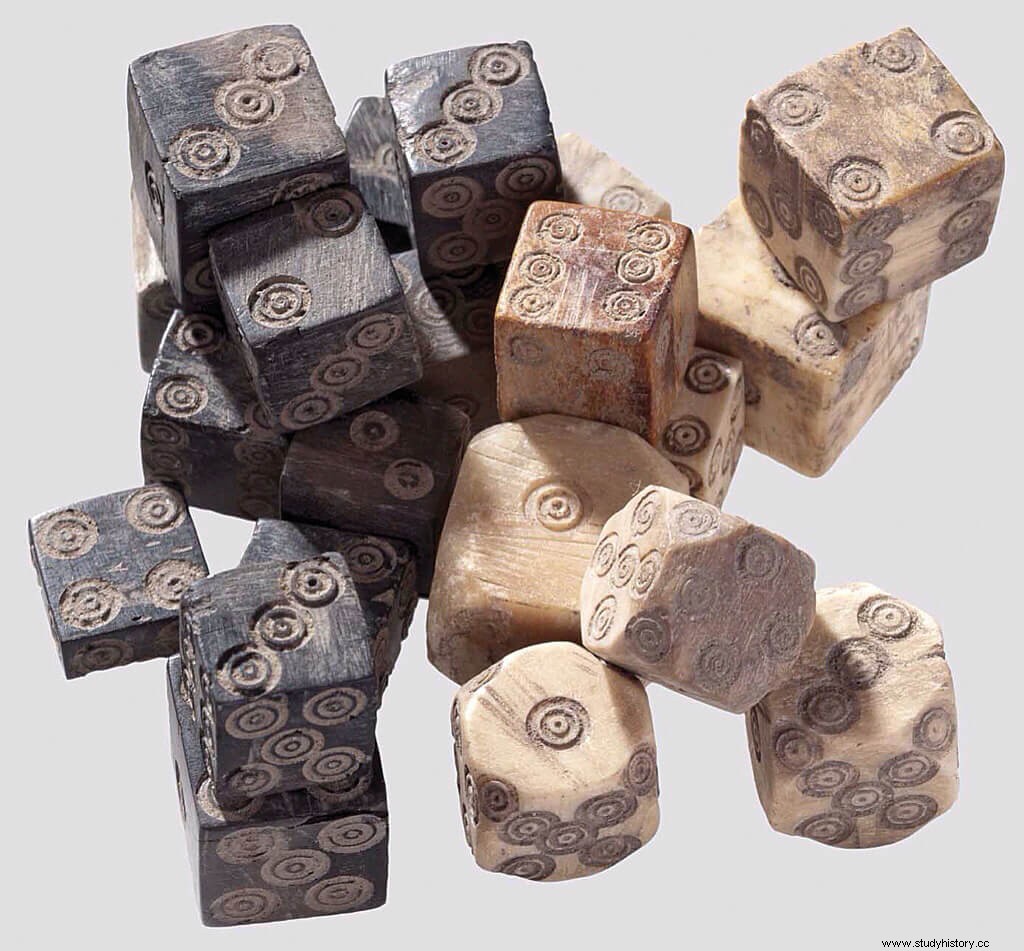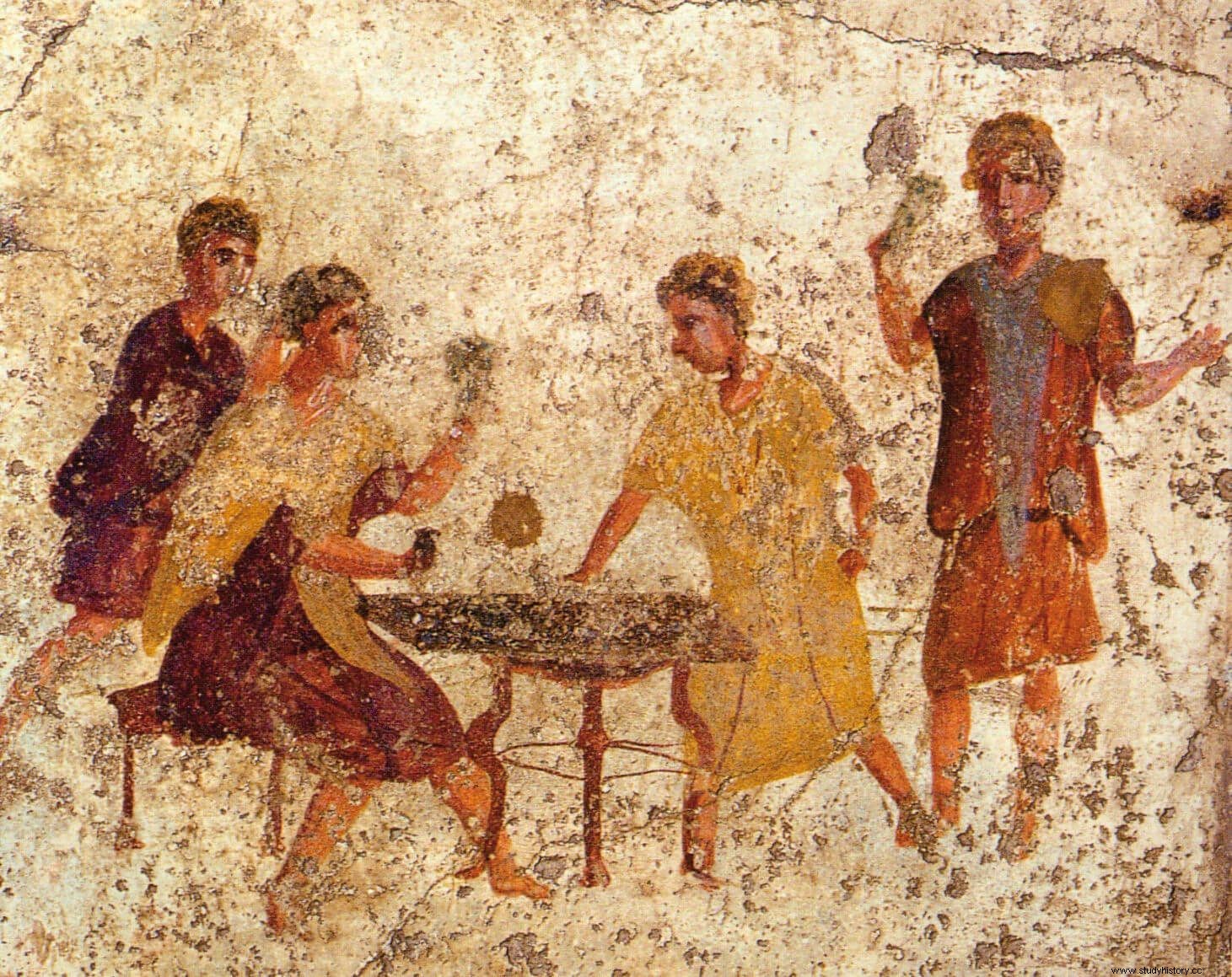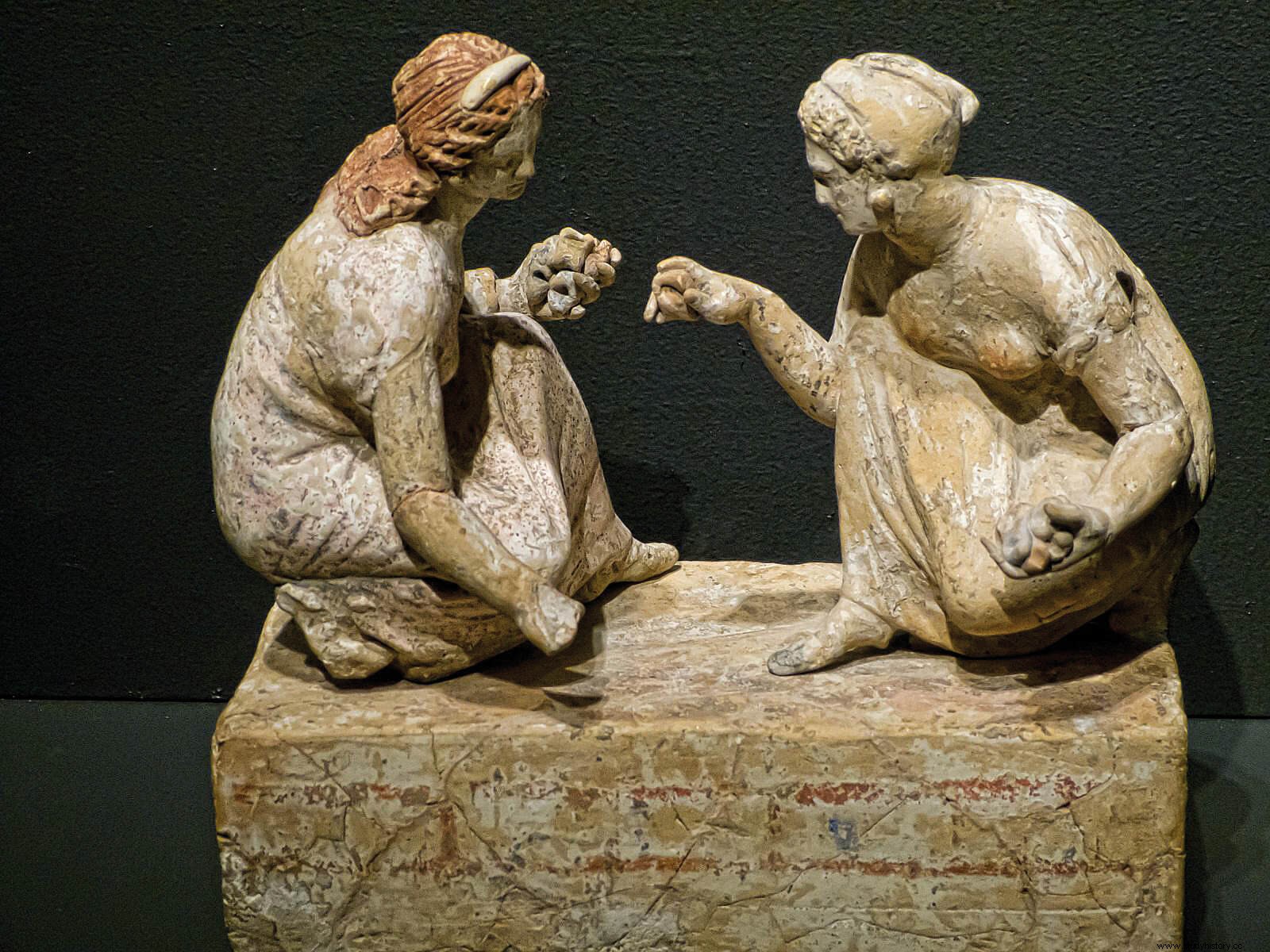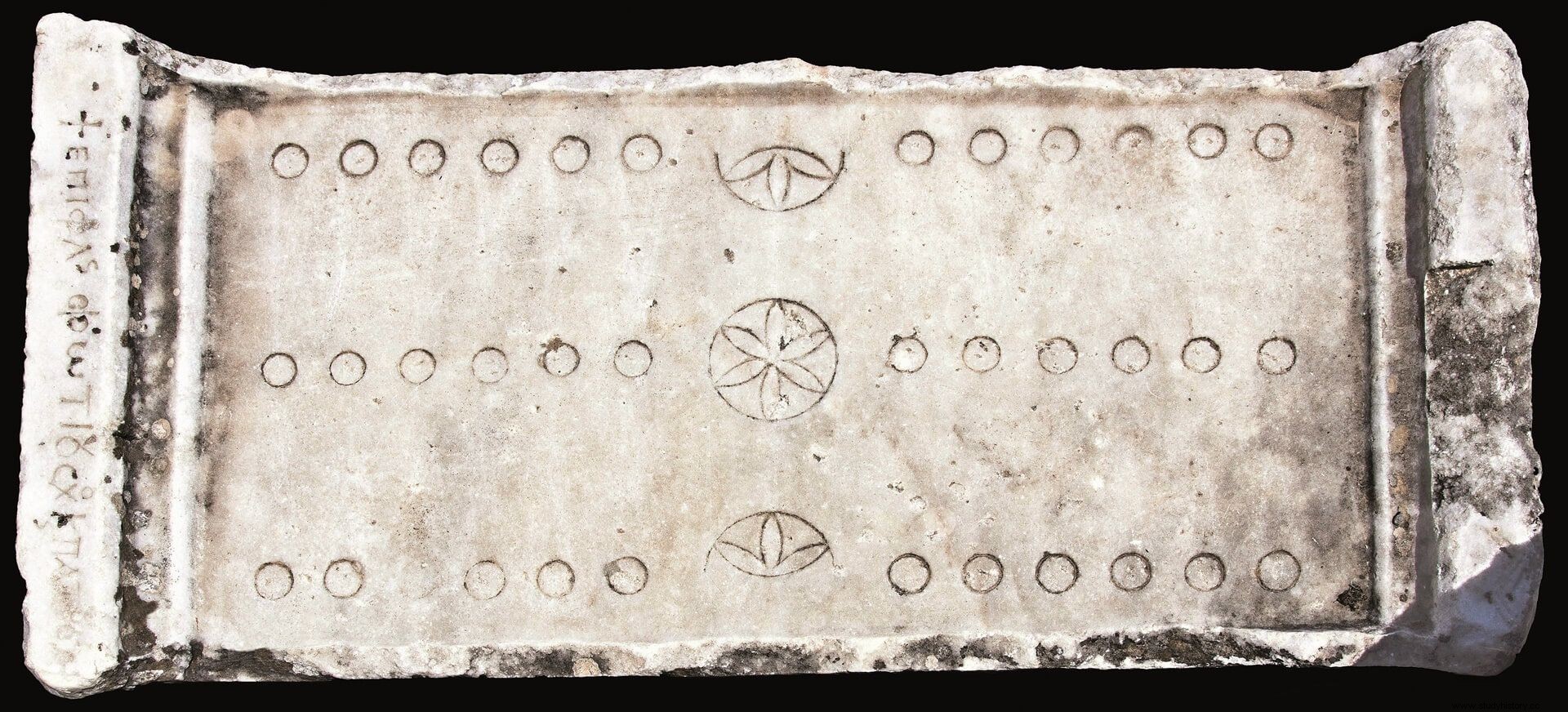
The game exercised a constant fascination between Romans of any social class . It was very popular with the rich, and many of them played at night under the austere gaze of the statues of their ancestors. Immense fortunes were won or lost while the slaves lay frozen and forgotten, or so the satirist Juvenal would have us believe (Sátires , I. 93-95). Even emperors indulged. Augustus gambled frequently, though only in modest amounts (Suetonius, Augustus , 71). Nero , on the contrary, he used to bet higher:a minimum of 400,000 sesterces, enough to make a man a knight (Suet., Nero , 30), while Claudio was so fanatical that he even wrote a book on the subject (Suet., Claudio , 33). At the other end of the social scale, blue-collar workers played dice even when the weather was so bad that they couldn't work outside. It was also the last pleasure left to old men and successful prostitutes who were able to play well at the betting table. Even the children, playing games of chance with nuts as prizes, practiced the skills they would later need when gambling with money.
Such fascination is reflected in a large number of spaces in which the Romans used to play. Engraved game boards have been found in all kinds of public places , particularly in the forums and basilicas, and one was even found in the house of the Vestal Virgins. Military camps are also an optimal place to find graffiti of this type. In the domestic sphere, the game usually followed the meal, and the dice conferred a kind of ideal relaxation after dinner. For ordinary people, taverns provided an immediately ready space for gambling. Some had rooms in the back with tables and chairs – only the rich reclined – that could be used for different purposes such as eating and playing. Indeed, it was one of the main sources of income for a tavern, since it provided a micro-complex of entertainment for the average person:hot food, drink, gambling and prostitution; all this included in a simple establishment. The game boards themselves often had small marginal spaces in which some witty or ironic reflections were inscribed:
SPERNE LUCRUM / VERSAT MENTES / INSANE CUPID
“Reject riches, insane greed corrupts the mind”
Popular games
There were many other game modes . The most basic option was to draw lots, as the soldiers did when dividing Jesus' clothes after nailing him to the cross (Juan , 19.23-24). Another very simple game was called micatio , which was a kind of old version of “rock-paper-scissors”. On three, each of the two players would show a hand, but the number of fingers extended would vary. At the same time, they would both declare how many fingers they expected there to be in total. The real honest man was the one you could play micatio with. even in the dark. Some more complex games included the duodecim scripta , which seems to have been similar to modern backgammon , the latrunculi , comparable to chess, and the tabula , which could be played on certain boards commonly found in taverns. Unfortunately, the rules for these have not survived, and in any case it would probably be wrong to think that standardized rules existed for the entire Empire and its great longevity. The knucklebones (tali ) were also frequently used for gambling. These were small leg bones – between the shin and the ankle – of quadrupeds, and each of them had four faces to which different scores were assigned:1=the flat face, which was known as canis (“the dog”), 3=the convex side, 4=the concave side, and 6=the curved side, known as the sine ("the old man"). Bones were thrown four at a time, and in one well-known example, the bowler put 16 sesterces into the pile betting three dogs or a six, but the winner kept all after drawing a Venus (one knuckle from each face). I've even calculated the odds of drawing a Venus – an entire day of throwing jacks thousands of times – as roughly 26 to 1. The winner must have won a lot of money given the amount of the initial bet.

The circus races and the gladiatorial games in the arena they also offered splendid gambling opportunities. The potential bettor had plenty of information to help him assess each competitor's chances of winning. The arena programs offered lists of the statistics of each fighter , just like those of the horses in the circus. Rumors and comments about the charioteers or the pedigree of the horses are preserved in contemporary writings, and in the days before a festival, the gossip ended up turning into bets. A passage from Ammianus Marcellinus is most explicit in relation to the passion of the plebs in Rome in the fourth century:
These, everything they live, they waste on wine, dice, games, pleasures and shows. For them, their temple, their home, their assembly and the hope of all their wishes is the Circus Maximus. And, in fact, they can be seen in the squares, alleys, avenues and meeting points forming groups in which they discuss their differences and defend one or the other, as often happens. […] they swear over and over again that the state will not be able to survive if, in the next race, their favorite charioteer does not leave the starting line first and does not make very risky turns with their ominous horses (Amm. XXVIII. 4.29-30, trans. M.ª Luisa Harto Trujillo, Madrid:Akal).
In the circus, bets were placed on the four color categories of the runners – blue, green, red and white – that represented the four schools. There is no evidence in any of the ancient writers to explain the formulas to us. Most likely, they each bet with those sitting near them in the crowd. This could explain why the colors were paired together in the popular imagination (blues and reds against greens and whites). Pairing up in this way would make it easier to place head-to-head bets without having to contemplate complex combinations of possible outcomes.
Random Lives
But why was the game so popular among ordinary people? Perhaps the game can be understood as a useful practice to learn some skills and attitudes potentially useful in daily life. The game emphasized the importance of money among the community; it was a kind of reflection of daily life, in which uncertainty and volatility were frequent. At the same time, it also enhanced the relevance of status. The most important thing about the game was precisely that a good player could win large amounts of money and improve his social position. Suetonius's description of Caligula caricatures him as the typical ambitious and aggressive commoner, always ready to cheat to achieve his goals (Suet., Caligula , 41). The game also taught how to take risk and make decisions under pressure. In a world where poverty was never far away and income always subject to the effects of crop failures or the arbitrary patronage of elites, the common Roman needed to learn the skills necessary to control the risks facing him and his family. family.
The games required the learning of a significant volume of detailed information, often including a high degree of numerical sophistication. We can imagine that this was good training for handling the small personal debts that were easily incurred among the lower classes. At the same time, these practices emphasized the importance of deploying a wide variety of tactics in the field of interpersonal relationships. First of all, it demonstrates the importance of keeping an eye on your neighbor if you want to avoid being scammed. On the other hand, it also shows the importance of asserting one's status or being prepared to protect it, albeit aggressively. It is worth noting that the Digest section which covers the laws relating to the game repeatedly mentions the use of violence. Not that they were thugs, either, and as Ammianus mentions in his description of the Roman plebs, the players tended to maintain a genuine sense of camaraderie (XXVIII.4.21). In short, it taught the common Roman how to deal with money, risk and people .

The popularity of the game among the classes currents It is also a good reflection of what chance could come to represent in their lives. This is an aspect that can be perceived through the knucklebones, which were also used to consult the gods. An oracular column found in the Kremma forum, in Pisidia (Turkey), was inscribed with the answers to 56 possible rolls of five knucklebones. The answers even had names:rolling a 10, which is equivalent to the throw of the Tyche helmsman [Ed:Tyche is the Greek name for the goddess Fortune, and the helm is one of her usual attributes, symbolizing the randomness of destiny], means no it is time for frivolous enthusiasm, which can be “very harmful”. The advice is then to wait because it is the indicated time for waiting. If the querent can do it, then he can "accomplish anything." Rolling a 22 results in a “don't worry, the moment is not yet ripe. If you make useless efforts in vain, you will pursue a goal that is out of reach. I don't see the right time, but if you relax a little, you will succeed.”
A proverb said that:“we must control our good fortune or it will control us”. What we see in gambling and in oracular dice is the belief that luck was not unstoppable, but could be manipulated and influenced. Perceiving the world in this way meant giving space to hope and individual intervention. The game then reflects a conception of the world in which ordinary people, despite their modest condition, had an opportunity to improve their luck instead of seeing their lives as dominated by chance. To be honest, it required knowledge, skills, experience, guts and brains, but even so the opportunity existed nonetheless, allowing the average Roman, who had to survive in an environment where risk abounded, to cope with such a level of uncertainty. .
Restrictions and legislation
Despite being so popular, the game was subject to the fiercestmoral condemnation . Gamblers are mentioned in the same breath as adulterers and other vile people. It was said that the more ingenious the player, the greater his perversity. The dangers of the game were sometimes associated with threats to the state:Catilina's co-conspirators were described as random (“players”), and the allusion to Julius Caesar is well known. to the Republic as a bet to win or lose when, crossing the Rubicon, he pronounced his famous phrase:"the die is cast" [NdE: Alea iacta est . Literally:“the die is cast”]. The gambling activities of certain emperors also offer clear examples of their degeneration. Domitian was vilified for playing dice even in the morning, and Caligula not only played dice while the court mourned his sister, but even cheated (Suet., Domitian , twenty-one; Caligula , 41; Seneca, Dialogues , XI.17.5).
Moral disdain was also reflected in the laws. The Lex Random , probably dated in the year 204 a. C., was the first attempt to legislate against the game, but other laws followed, trying to eliminate this popular practice. The Lex Talaria banned dice games except during meals or during the festival of Saturnalia . The penalties for non-compliance ranged from four times the amount wagered to exile. It does not appear that these laws were enforced. Aediles were content to oversee taverns, but the large number of game boards that have survived to the present day suggests that they did not take this responsibility very seriously. Two republican laws allowed betting on competitions conducted in pursuit of virtue [NdE:Virtutis causa (Seneca, Ep. 106.11; 117.30). Gambling was authorized where one did not actively participate in the game, for example as a spectator], which allowed gambling in the circus and the amphitheater. In any circumstance, gambling debts were legally irrecoverable. The praetors also appear to have refused to act against owners of gaming establishments affected by assault, robbery or damage resulting from these activities. We don't get the impression that the law took the game very seriously.

Why then were the elites rejecting the game while many of them had fun with him? In part we can understand this phenomenon as the result of the intention to protect their status. Gambling could result in social mobility in which neither work nor birth was taken into account, posing a threat to the traditional social hierarchy . Furthermore, it was also linked to the urban popular culture that had grown up alongside the immense imperial city of Rome. Associated with the ubiquitous culture of the tavern, the game seemed to represent for the elites everything that was wrong with the lower classes. It showed that people are unable to use their leisure time intelligently or morally acceptable without supervision.
The reality, of course, was different. The all-powerful persuasion of the game was not just an example of the idleness of the plebs. It represented a politically correct topic for speech and provided intellectual stimulation as well as particular emotion. Most of the play was certainly done on such a small scale that it was neither reckless nor affected the status of the participants in society. How much the average Roman would gamble is impossible to know, but in a way no figure would have been insignificant. Playing in a group, where there are no runners taking a cut, is to a certain extent a saving, although at a zero interest rate. In the long run, each participant can wait his turn to win. Victory simply represented an exaggerated form of quick money that dominated ordinary life:a good week followed by a bad week and so on. It may be that the elite understood that gambling really did pose a threat and failed to enforce the laws accordingly, but it is more likely that, like their anti-gambling rhetoric, the laws were just statements purely designed to publicly emphasize that gambling was not the right way to succeed .
Bibliography
- Horsfall, N. (2003):The Culture of the Roman Plebs, Bristol:Classical Press.
- Purcell, N. (1995):“Literate Games:Roman urban society and the game of alea”, Oxford:Past &Present, 147, pp. 3-37.
- Toner, J. (1995):Leisure and Ancient Rome, Cambridge:Polity Press.
- Toner, J. (2009):Popular Culture in Ancient Rome, Cambridge:Polity Press. Translated into Spanish as:Sixty Million Romans:the culture of the people in ancient Rome, 2012, Barcelona:Crítica.
